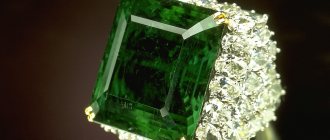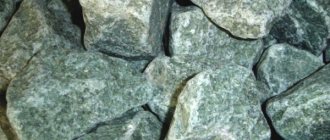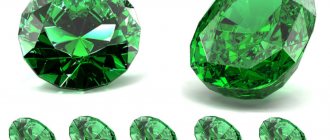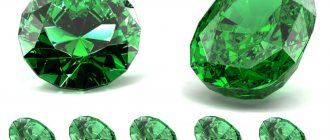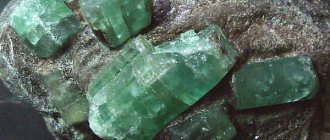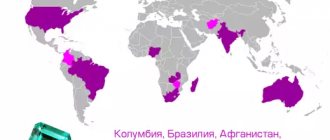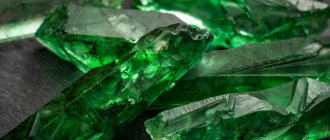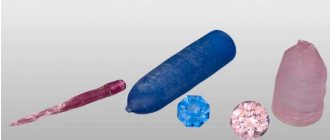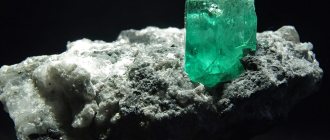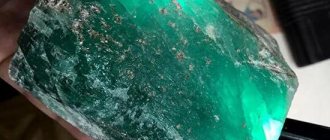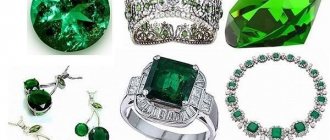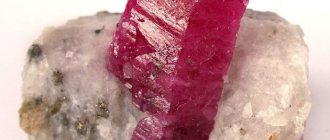Emerald is a beautiful gemstone from the beryl group. Once upon a time, he was a real favorite of Cleopatra: the queen decorated her clothes with emerald scatterings and gave crystals to those close to her with the image of her profile. In ancient times, emerald was called “smaragd”.
Rings, pendants, earrings and other jewelry with emeralds are relevant at all times. This is an excellent gift option in honor of a memorable event or celebration. Today, emerald rings are worn by both men and women.
Features of the stone
Emerald is one of the most expensive stones. Pure examples of rich shades of green without inclusions weighing 5 carats or more usually cost more than diamonds. From the point of view of jewelry, transparent stones are ideal, in which the color is evenly distributed over the surface. Natural stones often have various inclusions and cracks and may be cloudy.
The emerald cut is most often used when processing stone. Other popular options include:
· “Cabochon”, “Heart”;
· “Ball”, “Princess”;
· “Marquis”, “Drop”.
The beauty of the stones is well emphasized by a frame made of white or yellow gold. Gold rings with emeralds are a true jewelry classic. The vibrancy of the dark green color is evident in the platinum frame.
Emeralds form spectacular combinations in tandem with diamonds, garnets and rubies. Models with one large emerald surrounded by a small scattering of diamonds look very elegant.
Weight in carats.
Carat denotes the weight of gemstones. One carat is equal to 200 milligrams or 0.2 grams. The larger the size, and therefore the weight of the stone, the higher it costs.
However, the price change is not proportional to the weight of the stone. That is, if there are two stones with the same characteristics, but one is twice as heavy as the other, then the price of the larger stone will be much more than double. This is due to the fact that large specimens are quite rare and therefore expensive.
It is even rarer to find a large emerald of good quality. Such a copy will cost a lot of money.
Varieties of emerald
Stones are classified according to their place of origin. They differ in depth and saturation of shade, as well as color scheme.
· Colombian emeralds have a distinct blue-green color and minimal defects. Some of the most expensive samples are mined here.
· Brazilian - light green emeralds, distinguished by their large sizes.
· Zambian - clean and almost transparent stones of a yellowish-green hue.
· Egyptian - the brightest stones of a blue-green hue.
· Ural - opaque, rich green stones.
The color of emerald depends on the amount of impurities included in the composition: chromium oxide, vanadium and iron. Thus, stones mined in the Urals have a rich green tint due to their high iron content. Ural emeralds, as a rule, are used in their most natural state and are subjected to only minor processing. Vanadium in the composition gives the stones pleasant bluish notes, and chromium gives them dark green notes.
Natural emerald. How to choose so as not to run into a fake?
Emerald, like sapphire and ruby, is valued depending on where it is mined. If for a ruby the “password” is Burma, and for a sapphire it is Kashmir, then for an emerald it is Colombia, or more precisely, the mine in Muzo, near Bogota, where stones of the most beautiful grass-green color are mined. Most emeralds have defects that are much more pronounced than those of sapphires and rubies. By the way, friends, if you don’t have time to read this article in full, then look at our channel for a detailed review about emeralds. There is all the information from the properties of the mineral to its care, as well as details on how to distinguish a real emerald from fakes and imitations.
Many emeralds are not even transparent; at best they have a green color, but no sparkle. Very large emeralds are not uncommon; When mining, you come across crystals that go meters deep into the rock. One day, a man approached the jewelers who was the owner of an emerald crystal eight inches long, three inches in girth and weighing several hundred carats. It was a real emerald, but it looked more like a piece of frozen lemon ice cream than a precious stone. It could be of some interest to a mineral collector, and was, in fact, suitable only for paperweights. You can imagine the disappointment that this meeting brought to the owner of this giant. Inclusions of three stages (liquid, gas, solid) with a typical jagged shape, a distinctive feature of Colombian emeralds. (40x) For thousands of years, emeralds have been highly valued. It is believed that some excellent examples came from India, but they are unlikely to have been mined there, most likely the result of trading operations by Spanish merchants who discovered deposits in South America in the 16th century. In jewelry circles there is often talk of "antique stones"; Usually these are samples of a rich green color that appear on the market quite rarely, and are almost never found in new deposits. It is for them that they give the highest price. It should be noted that emeralds of this quality and size are as rare as the best Burmese rubies, and almost never come to market. Natural emerald is a beryl silicate, and its color is in most cases due to traces of chromium, the element that gives Burmese rubies their distinctive red color. When viewed through a color filter (which absorbs all colors except red), most emeralds appear red or brown due to the presence of chromium. Using this test, you can immediately distinguish an emerald from other green stones and rhinestones, but you cannot rely on it completely, since some emeralds, especially those colored with vanadium, will remain green, and artificial emeralds will be as red as natural ones. Emerald is a relatively soft mineral (its hardness is 7 on the Mohs scale), its surface is easily abraded, and scratches remain on the edges. If an emerald has been stored in the same container with diamonds, sapphires and rubies for a long time, it can appear almost dull, lacking luster due to constant damage from harder materials. The owner was offered only £500 for one of these stones, but after it was re-polished, the price increased tenfold. Filled and hollow cracks in Colombian emerald form a garden. Cracks that reach the surface of the stone are filled with oil to improve the appearance. (4x) Colombian emeralds are characterized by the simultaneous presence of inclusions of “three stages”: these are flat cavities with jagged edges, filled with liquid, and also containing crystals or gas bubbles. Natural emeralds from Muzo often contain small crystals of calcite or fluorite, similar to those found in Burmese rubies. Emeralds from the Chivor deposit (also of high quality) are characterized by inclusions of small crystals of iron pyrites. Other large emerald deposits are located in Siberia, East Africa, the Transvaal, India and Pakistan. Specific growth features on the basal surface of Colombian emerald. This pattern is indicative of the uneven growth pattern typical of Colombian emeralds. (15-fold) Each region is characterized by special inclusions; the most recognizable of these are found in emeralds from Sandawana, Zimbabwe, which first appeared on the market in the late 1950s. The best specimens obtained there are close in color to those of Colombia. Adding to the confusion is the fact that they have relatively few defects and can pass for valuable “antique stones.” However, experts distinguish them by their color being too dark, almost black, too rich and deep, and, accordingly, lacking play. Fortunately, Sandawana emeralds are distinguished by characteristic inclusions, traces of tremolite, the rock from which they are mined. These inclusions are so different from other “defects” characteristic of emeralds that, once you become familiar with them, they are then easy to distinguish. In addition, stones weighing more than 5 carats are rarely found in Sandavan. Yet quite a few buyers have chosen emeralds from Zimbabwe for mind-boggling sums, mistakenly believing them to have come from Muzo. However, not all natural emeralds “hidden their origin.” For example, the price of pale matte emeralds mined in Habatal in the Austrian Tyrol was low. Their color was enhanced by placing green reflective foil in the closed frame of the stone. Other stones that are confused with emerald An artificial emerald is more difficult to distinguish from a real one than in the case of a sapphire or ruby. The streets of Bogota, the “emerald capital” of Colombia, are full of gem dealers selling artificial emeralds that even a knowledgeable amateur is unlikely to distinguish from real ones. When people come to Colombia, Brazil or the Far East, they think that since there is mining here, both respectable merchants and street hustlers sell exclusively natural stones. In fact, firstly, they choose and purchase emeralds at a price no less than in Europe or the USA, and secondly, and this is the worst thing, they may well get a low-quality stone, artificial or even rhinestone. The gemstone market is international and most dealers, whether in Bangkok or New York, are well aware of the value of their goods. It is worth remembering that the processes for making artificial emeralds are constantly being improved, and synthetic minerals are appearing on the market, which only a professional gemologist can distinguish from natural ones. The practice of “oiling” emeralds is little described, but is used often enough to warrant mention. During this process, the stone is immersed in oil, sometimes with a green pigment, which penetrates the stone through tiny cracks that reach its surface. This not only enhances the color of the emerald, but also masks surface defects. Typically, traces of such treatment are visible under a microscope, and modern cleaning methods, especially ultrasonics, make the process reversible. It also happens that artificial stone is glued onto the surface of low-quality natural stone to improve its appearance, although this practice is not particularly common. Of all the natural stones that are similar to natural emerald, only fluorite poses a problem. Fortunately, this mineral can only pass for a low-quality emerald, but when examined under a magnifying glass, you can often notice the famous “three stages” inclusions characteristic of Colombian stones. It also appears red under a color filter, as do most emeralds, natural and synthetic. However, checking with a refractometer will put everything in its place: fluorite has a single refractive index, approximately 1.43, while emerald has a double refractive index, approximately 1.58. True to its name, fluorite fluoresces strongly (purple under ultraviolet light), it is too soft for a gemstone, only 4 on the Mohs scale, and therefore will always have abrasions or scratches on the edges. Tourmaline, jade, olivine, green sapphire and zircon are usually so different in color from emerald that it is almost impossible to make a mistake, in addition, their refractive index is higher. An interesting fact: if you mistakenly buy jade instead of an emerald (the best examples of which are transparent), you can end up with a much more valuable stone than a bad emerald. Natural emerald is often the target of counterfeiting. Doublets are produced in a variety of ways, and it is especially difficult to select and distinguish them if it is emerald on emerald. In this case, both inclusions and instrument readings will testify to the naturalness of the stone. Additional complications are introduced by the cutting and green dye, which is added to the adhesive composition. An artificial emerald grown by melting, with traces of melting in the shape of a hexagon. (5x) All other doublets can be recognized by a simple refractometer test, the same goes for rhinestones. You just need to remember that the green glass used to make them is often of low quality, and to the naked eye its defects may appear to be inclusions characteristic of emerald. When going for stones, do not forget to take a magnifying glass: with its help you will quickly understand that what you are looking at is not inclusions, but chains of air bubbles or cracks inside the glass. The fear of purchasing a fake may discourage some buyers from purchasing emeralds, but in fact, artificial emeralds are quite rare on the jewelry market. Many countries have adopted special “buyer rights protection acts”, according to which a stone that turns out to be a fake can be returned to the seller. A universal means of protection against counterfeiting is, of course, having a certificate from a reliable gemological laboratory; It's better to pay for a check than for a fake.
Interesting properties
It is believed that emeralds are more feminine stones. They help to reveal beauty and femininity, protect against rash actions. They relieve stiffness, help you gain self-confidence and give you a positive attitude towards life.
· Esotericists believe that emerald is capable of showing the future. It is believed that the stone protects the human soul from the negative influence of extraterrestrial entities. Cleanses energy, helps to find mutual love and find family happiness.
· Astrologers are confident that the emerald will be an excellent talisman for representatives of such signs as Cancer and Pisces. Emerald jewelry will help Taurus achieve their goals faster, reveal their intuition and creativity. For signs of the air element, the stone will allow them to concentrate and reduce anxiety.
· For mothers and pregnant women, emerald gives health and harmony in relationships with children. The aura of the stone attracts family well-being and helps those who are looking for their other half.
Rings and bracelets with emeralds protect owners from negative influences and help maintain peace of mind.
Treatment.
There are many ways to treat emerald to improve its quality. For example, internal cracks in stone that reach the surface are filled with resins to hide them.
Such methods are common practice. However, you need to keep this in mind before subjecting your emerald jewelry to ultrasonic cleaning. Ultrasound can destroy fillers, so in this case it is best to use gentle cleaning methods. For example, use a damp cloth to remove accumulated dirt.
Sometimes emeralds are dyed to deepen their color. But such stones are considered less valuable and therefore they are cheaper.
Emerald ring: nuances of choice
Before choosing an emerald ring, pay attention to the criteria that determine the quality of the stone.
· Color. The reference is considered to be a dark green and green shade, perhaps with a small admixture of blue.
· Purity. It is determined by the number of microcracks, bubbles, rock residues and other foreign inclusions. Absolutely transparent stones practically never appear on the open market.
· Transparency. Faceted stones that have a uniform, uniform color are highly valued.
The design of the ring should be in harmony with the image and hands of the owner. So, girls with long fingers will be decorated with dyes with large geometric stones. For wide fingers, rings with inserts in the shape of a pear or a drop are suitable.
The best emeralds on the market
Mining is carried out mainly in South America - at the Muso mine in the vicinity of the Colombian capital. South American gems are considered the best in the world. A distinctive feature of these specimens is the color of young greenery and a bluish tint (the result of the presence of vanadium in the composition).
Deposits have also been found in Brazil. This country produces 15% of the world's mineral reserves. 30% of emeralds are found in African countries (Zambia, Zambezi and South Africa) and Pakistan. Moreover, stones of African origin contain iron inclusions and are distinguished by a yellowish tone. Such crystals are often confused with beryl and chrysolite.
High quality gems are mined not only in Colombia and Brazil. There are known deposits in Madagascar, Afghanistan, Nigeria and Russia (mines of the Urals).
Before choosing an emerald, you need to pay attention to the country of origin; information about this is in the certificate. Many manufacturers use the word “emerald” as a trade name, passing off cheaper minerals, synthetic crystals and even glass as natural stone. If you have any doubts, you should contact an expert who will determine the origin of the gem based on its composition.
What to look for when choosing
Under the guise of emerald, synthetic stones, doublets and triplets, as well as imitations can be inlaid into rings. High-quality imitation stones, grown in a laboratory using a geothermal synthesis process, have properties comparable to natural emeralds. However, stones of natural origin are of great value - they do not deteriorate when exposed to sunlight and are not susceptible to scratches.
· In ultraviolet rays, real emeralds acquire a brownish-red hue. But this method will not help identify imitation stones, since they also glow under the influence of UV rays.
· Duplexes and triplexes, consisting of several stones, can be distinguished by inclusions at the gluing points. Natural emeralds are not layered.
· When viewed from different angles, the emerald has a green-blue color; sometimes golden shades can be visible.
· The authenticity of high-quality large-sized emeralds is necessarily confirmed by gemological certificates.
· Inside natural stones there are cloudiness and inclusions: scratches, abrasions, microcracks.
Framing.
The setting of the emerald should protect it and preserve it so that it does not fall out. For better protection, it is best to use V-shaped teeth. This setting is best suited for angular shapes.
It is better if V-shaped teeth are placed at the very corners of the stone to protect its edges from possible impacts and damage. Also the safest is a blind setting.
It frames the stone around the entire perimeter with a metal strip, which protects it from external influences.
The blind frame can be full or partial. That is, completely edging the stone or some of its sections.
How to choose the right size
A special device called a ring gauge will help you determine the appropriate size of an emerald ring. It is easy to find in any jewelry store. But you can measure the circumference of your finger yourself. To do this you will need a lace, thread or a strip of paper. Wrap the thread around one of your fingers, then bring the ends together and trim off the excess. The resulting segment is the circumference of your finger. The diameter of the inner contour of the finger determines the size of the ring.
What else is important to know when choosing a size:
· For narrow (2–6 mm) rings, select a smaller size, and for wide (6–8) rings, vice versa. So, for a finger with a diameter of 18.2, a narrow ring of size 18 and a wide ring of size 18.5 will be suitable.
· Finger size can change by 0.5 sizes per day. Therefore, measurements should be taken in the middle of the day, when the fluid balance in the body is at an optimal level.
· The ring must pass freely through the phalanx. The girth of this part of the finger is also worth considering.
Synthetic product versus analogues.
Imitation emeralds are made from another similar material. Synthetic (or artificial) emeralds are created in a laboratory and have the same properties and characteristics, the same structure and composition as real ones.
Since they are man-made, they are less valued and worth less.
It is important to know if the emerald you are buying is created in a laboratory, as these stones are cheaper, so as not to buy a synthetic emerald at the price of a natural one.
Compared to natural emeralds, synthetic emeralds generally appear cleaner because they do not have as many visible internal imperfections as their natural counterparts.
Many (but not all) synthetic counterparts also show a red glow when illuminated with ultraviolet light (however, this is not an accurate test, as some natural emeralds also glow red under similar conditions).
Although there are some clues that can help identify man-made stones, it is very difficult to tell whether an emerald is synthetic or natural just by looking at it.
As a rule, the best way to find out for sure is to test it with special equipment. Therefore, if you want to be sure, ask for a certificate confirming the origin of the stone or send it to a laboratory for analysis.
Emeralds are one of the most beautiful and expensive gemstones, and many people want to have them in their jewelry collections.
However, there are many emerald jewelry on sale that are actually fake. Let's see how you can recognize such emerald imitations.
Range
The jewelry market offers various, there are enough of them. However, the range of silver jewelry is poorer than gold; some domestic brands do not have silver accessories.
Frame, cut
The frame of the product with emeralds is platinum, gold or high-grade silver:
- gold in white, yellow or pink is equally aesthetically pleasing;
- abrasion resistance has made platinum the material of choice for wedding rings;
- artificial or hydrothermal inserts or cabochon stones are framed in silver - this is a budget option.
Jewelry with emerald
Gold and platinum are the choice of aesthetes, sophisticated people for an evening wardrobe or lovers of shocking in ordinary clothes.
The trend in the silver jewelry segment is unpolished large stones and deliberate carelessness of a frame made of light or blackened metal. Also for lovers of delights with an average income level.
The stone was awarded a personal cut. A stepped rectangle or square with beveled corners is an emerald cut. Muddy, cracked, or other defects-stained specimens become cabochons.
Origin
Most mass-produced emerald jewelry contains hydrothermal inserts.
All Soviet jewelry from the 1950s to the 70s offered in jewelry stores has synthetic crystals inserted into it. But the tag doesn't say this. This must be taken into account when evaluating an inheritance or buying antiques.
Regardless of where they are mined, bright green stones with blue tints are traded as “Colombian emeralds”, while lighter stones are called “Brazilian emeralds”. Specimens from the laboratory come as “chatham emerald”.
| Property | Description |
| Chemical formula | Be3Al2(SiO3)6 |
| Selection form | Hexagonal prismatic crystals. |
| Color | Various shades of green from yellowish-green to green with a blue tint. |
| Transparency | Transparent, translucent. |
| Hardness | 7,5 8 |
Compatibility
In jewelry, the regal emerald is almost always complemented with white diamonds. Less often, gems of a similar level turn out to be neighbors: ruby, peridot, sapphire. For hydrothermal stones, white, blue or pink cubic zirconia are distinguished.
Earrings with emeralds and diamonds
Fake emeralds and purity.
Genuine emeralds are not completely pure as they have natural imperfections in their structure.
If you look at such a stone up close, preferably with a magnifying glass, you should see at least some imperfections such as lines, bubbles, crystals, etc. High clarity emeralds will have less of them, but they will still not be perfect.
Unlike real emeralds, man-made imitations usually look too perfect and clean, and if they are also relatively cheap, then this is a sure sign that you may be dealing with a fake.
One thing to keep in mind, however, is that synthetic emeralds can also look very clear and be quite affordable, even though they are not technically considered fake.
Definition of counterfeit: color and shine.
Genuine emerald comes in various shades of green, from dark to light.
Counterfeits are also green, but some have additional, non-green shades such as yellow. If you notice these secondary hues, keep in mind that the “emerald” could actually be another mineral, such as olivine or green garnet.
By holding the stone up to the light, you can also determine whether it is a fake. In bright light, natural emerald does not show intense colorful flashes (the so-called fire); Natural emeralds may have some fire, but it is minimal.
Some fakes, however, shimmer with all the colors of the rainbow, and this is a sign that the emerald jewelry is an imitation.
If the stone you are looking at is cut, carefully examine its facets. A real emerald is relatively hard, and the edges of its facets should not show significant signs of wear.
Because some imitations of emerald are made from softer materials such as glass, their edges become less sharp over time and appear worn.
